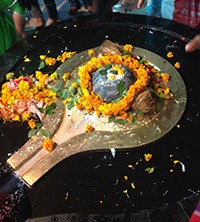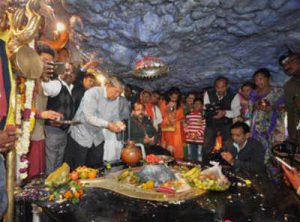Travelogue: The Cave Temple of Tapkeshwar
Nearby to Rishikesh, in Dehradun, there is an ancient Shiva cave temple known as Tapkeshwar Mahadev Temple. This temple is in a cave and, to get to the location, one has to transcend down several stair steps, to which you enter into what looks to be a village of temples.
The beauty of the location is enhanced by Mother Ganga, who flows rapidly just outside the cave.
In addition, this pilgrimage place contains several beautiful murtis and temples where sadhus have done their sadhana.
There is a magnificent energy in this location, which inspires one to worship.
Swamiji explained that the temple name has two meanings. The first meaning is “the place of Tapasya.” Legend has it that, during the era of the the Mahabharat War, this is the location where Dronacharya, the guru of the Pandavas and Karuravas, meditated and performed his Tapasya here.
 The word “Tap” means “to drip” and so, the second meaning derives its name from the constant dripping of water from the cave ceiling onto the Shiva Lingam.
The word “Tap” means “to drip” and so, the second meaning derives its name from the constant dripping of water from the cave ceiling onto the Shiva Lingam.
This cave has special significance and meaning to our Swamiji, as he used to come to this cave often when he was performing his own Tapasya many years ago. He recollected that he would come to the cave and spend the whole day doing Sadhana.
Upon entering the temple, we first worshiped the Shiva Lingam, which had become indented from the constant drips of water. Swami Ramkripaluji sang a devotional bhajan and Shree Maa and Swamiji made offerings to Lord Shiva, giving him a bath, flowers and other offerings.
Swamiji then went to meet the main priest to let him know we wanted to do sadhana. The priest graciously gave us a spot just above the Shiva Lingam to chant the Shiva Sahasranam.
The bhavana and the power of the temple cannot be expressed in words. One must experience this directly, we have tried to share through a slide show and a short video.


